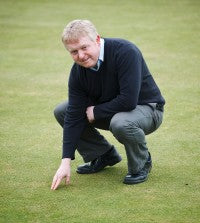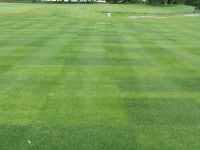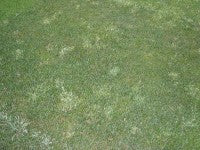Grass Seed - It’s simply a matter of breeding!
 With the vast number of perennial ryegrass cultivars available for use in the UK, selecting individual varieties to formulate a mixture can be a bewildering proposition. By definition, each and every cultivar has to be distinct from the rest; sometimes these differences are very subtle, but often they are decidedly pronounced .
With the vast number of perennial ryegrass cultivars available for use in the UK, selecting individual varieties to formulate a mixture can be a bewildering proposition. By definition, each and every cultivar has to be distinct from the rest; sometimes these differences are very subtle, but often they are decidedly pronounced .
For instance, with a quick glance across the British Society of Plant Breeders (BSPB) Turfgrass Seed plots at the STRI, most people could generally divide the large spectrum into two categories; dark green cultivars and bright green ones (see image above).
There is clearly a fundamental difference in colour between these two groups, which arises from them having varying genetic backgrounds. Not surprisingly, the two groups have additional large contrasts in a wide range of characteristics. Generally speaking, the dark green types have originated from breeding programmes in other continents (eg, North America), whereas the bright green cultivars are more typically bred here in Europe.
Use of the darker types, particularly in winter sports pitches, seems to be on the increase in the UK market; year-round darker green colour obviously seems an attractive proposition. But, is there a flipside to this apparent advantageous trait - is this grass truly greener on the other side?
Aesthetics versus winter performance
 Much of the dark green, North-American material is bred in areas with very harsh winters. Breeders have to select grasses that can survive prolonged cold. The dark types persist by shutting down and going through a long period of winter dormancy in growth; they show less growth under low light intensity. They do have aesthetic value as they tend to maintain their colour better in winter months (see table data for Barlennium), but this benefit is heavily offset by their inability to grow - and recover from wear - during this time.
Much of the dark green, North-American material is bred in areas with very harsh winters. Breeders have to select grasses that can survive prolonged cold. The dark types persist by shutting down and going through a long period of winter dormancy in growth; they show less growth under low light intensity. They do have aesthetic value as they tend to maintain their colour better in winter months (see table data for Barlennium), but this benefit is heavily offset by their inability to grow - and recover from wear - during this time.
The bright green breeding material has generally originated in Europe, where selections are made more for winter-active growth. In a breeder's trial subject to wear through the winter, those varieties that are still growing, and are able to recover during this time, will tend to fair best. They are simply better adapted to grow in low light levels and seem to be more efficient at using available light, particularly during the winter.
New material from the South of France has recently emerged via our breeding programmes and has proved particularly successful in UK trials. These varieties show good winter activity, with two having an added benefit of a very rich bright green colour for all but the coldest periods of the year (see table).
 These trials clearly point to the benefits of the predominant use of bright green cultivars in winter sports pitches in the UK, particularly in stadia environments where light levels are low. The use of a minor percentage of a dark type within a mix can be beneficial for certain reasons (eg, to help underpin a nice year-round mid-green colour), but an over-reliance of dark green material in a blend would be likely to have detrimental effects on winter performance under wear.
These trials clearly point to the benefits of the predominant use of bright green cultivars in winter sports pitches in the UK, particularly in stadia environments where light levels are low. The use of a minor percentage of a dark type within a mix can be beneficial for certain reasons (eg, to help underpin a nice year-round mid-green colour), but an over-reliance of dark green material in a blend would be likely to have detrimental effects on winter performance under wear.
Poa annua ingression
 An additional point of caution to make to anyone adopting a high proportion of dark types within their seed mixture, is to consider the aesthetic value of a sward with a proportion of Poa annua in it.
An additional point of caution to make to anyone adopting a high proportion of dark types within their seed mixture, is to consider the aesthetic value of a sward with a proportion of Poa annua in it.
The ubiquitous annual meadowgrass will visually blend far better with bright green ryegrass varieties than dark cultivars. This may be of minor concern to high-end football pitches that have the luxury of a full annual renovation but, for anyone managing a more permanent grass pitch, golf course or turf crop, this is a very important consideration. Regular viewers of US tour golf coverage will no doubt be familiar with the ensuing mottled green appearance of fairways and surrounds (see image above).
So, is this grass truly greener on the other side? The temptation to turn over a new leaf may be strong, but, in conclusion, it may not be the best course of action for turf managers in the UK, where the ability to withstand winter wear is paramount.
Table data: Data from the Turfgrass Seed 2013 guide's Table S1 - Barenbrug cultivars in ranking order. Note dark green winter colour of North American-bred Barlennium (dark-green type) and outstanding summer colour of Barorlando and Barcristalla (bright green type, bred in South of France)
Key: L Grd Cov = live ground cover; VM = visual merit; W-green = winter green colour intensity; S-green = summer green colour intensity
For more information call 01359 272000, email info@baruk.co.uk or visit www.barenbrug.co.uk .
